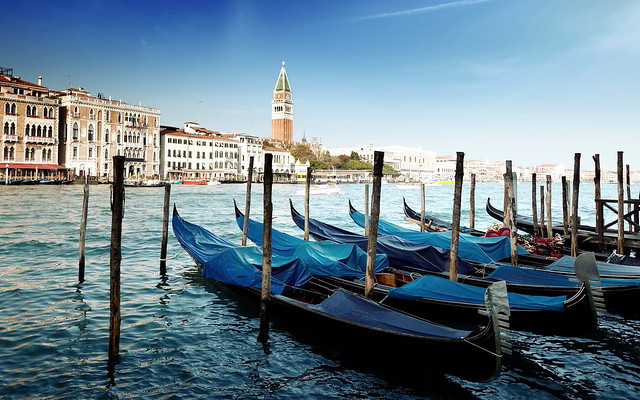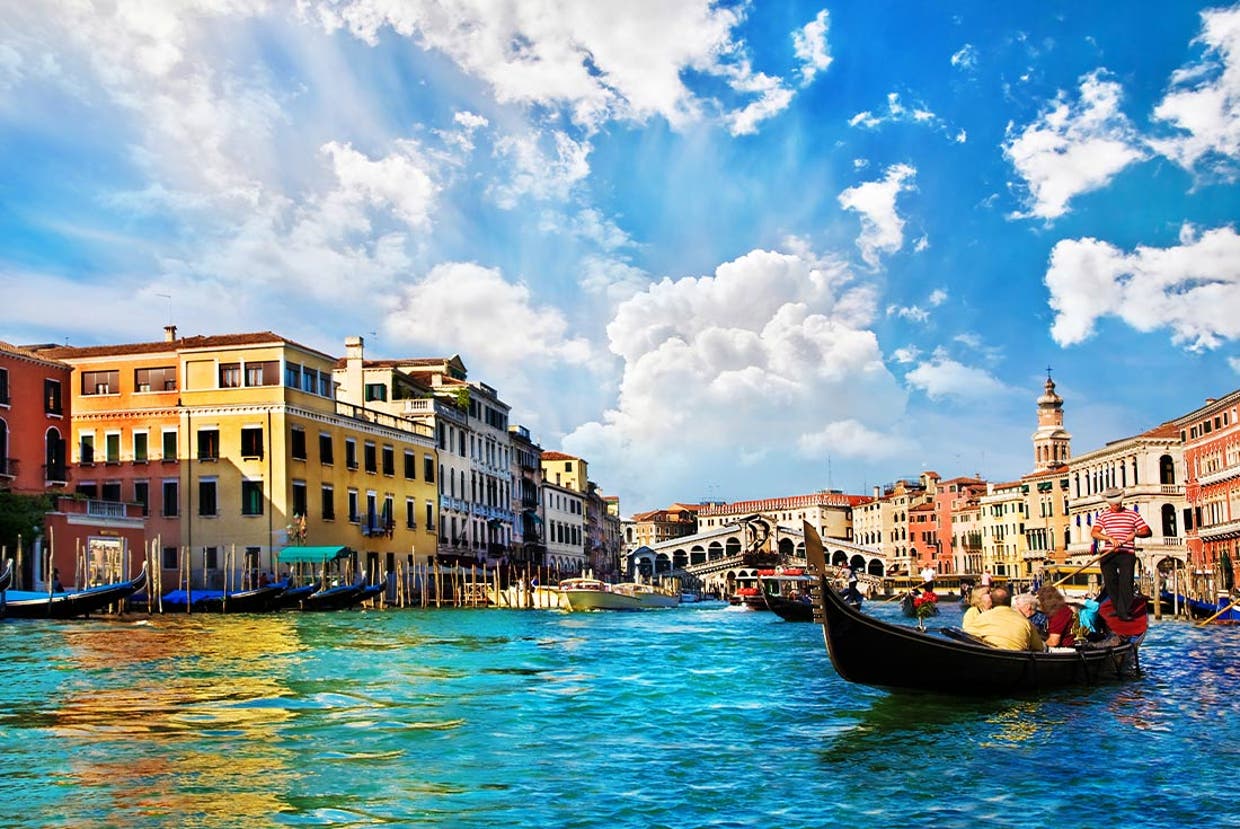Reminding us of the birth of Venus.
Venice... a town founded on a love of freedom, growing gradually in the silence of her lagoon, thanks to the determination and wisdom of its citizens.
Venice... most famous of cities, celebrated for her wisdom and justice, later declining in the vicissitudes of all human destiny. Venice... a unique city, in which the works of the greatest artists decorate the churches, guilds, and palaces, forming a wonderful treasury of art.
Finally, Venice... a city whose survival is watched anxiously by the whole world, and which can rightly be called an international city. Right at the dawn of her glorious history, in the fifth century, Venice was the place where a few fishermen had settled in clusters of pile dwelling on the islands of the lagoon. Only a few centuries later, a rich powerful town was developing; her ships began to sail down the Adriatic Sea, and thence to the eastern Mediterranean to set up a flourishing trading port. The theft of the remains of St. Mark the Evangelist in 828 from Alexandria in Egypt, is an indication of the kind of ambition of the Serenissima Republic. St. Mark is the prime glory of Venice and was adopted as her symbol on all flags, public buildings and coins. But above all else, St. Mark to Venetians means the Basilica, that noble building founded about the year 1000 A.D. which became the town's spiritual centre, the church of the Republic where important public events were hallowed in the name of the revered Patron Saint. Venetian art was originally inspired by the oriental forms of Byzantium; when the mosaic artists, working in the tradition of Ravenna, began to decorate St. Mark's, they used the church of the Twelve Apostles at Constantinople as a model
Later, the fourteenth century was characterised by a splendid interpretation of the flowering Gothic style, giving rise to wonderful works of art such as the Doge's Palace, with its superb Porta Della Carta (Gateway leading to the State Archives), Cà d'Oro, Cà Foscari, Cà Giustinian, Că Loredan etc. The most beautiful of the town's churches, masterpieces of Venetian Gothic, were built in the same period, with their soaring façades. e.g the church of St. John and St. Paul, Frari, St. John in Bragora and Madonna del l'Orto.
In the fourteenth century, painting begins almost as a branch of the goldsmith's art; the Byzantine altarpieces of Paolo Veneziano were among the earliest examples of pictorial art in the city of the Doges. The first great masterpieces of the fifteenth-century painters such as Vivarini, Bellini, Cima da Conegliano, and Carpaccio, mark the rebirth of Venetian painting During the fifteenth and sixteenth centuries, a new town of many-coloured marble takes the place of the medieval Gothic one. The Renaissance style, coming from Tuscany, is interpreted in this environment, in a new, personal way, just as the Gothic style had been. Combined with Gothic elegance, we find a taste for polychromed surfaces, and above all, an elegant decorative vein in all the architectural features. Thus we see during the Renaissance period the city being adorned by the facades of the Miracoli and San Zaccarla churches, and by the 'Scuole Great Guilds) of San Marco and San Giovanni Evangelista. The elegant Procuratie Vecchie Arsenale acquires a new, richly-adorned Gateway. in the Plaza on the left if one faces the Basilica and the imposing
Splendid new palaces appear along the Grand Canal, eg Vendramin Calergi, Corner Spinelli, Cà Dario and Camerlenghi.
Thus we see during the Renaissance period the city being adorned by the facades of the Miracoli and San Zaccaria churches, and by the Scuole (Great Guilds) of San Marco and San Giovanni Evangelista The elegant Procuratie Vecchie appear in the Piazza on the left If one faces the Basilica, and the imposing Arsenale acquires a new, richly adorned Gateway. Splendid new palaces appear along the Grand Canal. e.g. Vendramin Calergi, Corner Spinelli, Cà Darlo and Camerlenght
The sixteenth-century is the Golden Age of Venetian painting, besides the enormous progress made in the field of architecture by such masters as Sansovino and Palladio, there is also a great evolution in painting with the new style of Glorglone, soon to be widely imitated. In Giorgione wake came Tiziano. Tintoretto. Bassano and Veronese, leaving their priceless works of art in Venice. After the decadence of the seventeenth century, Venice rediscovers, new Inspiration in all fields a hundred years later Imposing new buildings rise to complete the naw powerful city. While all Europe envies the Serenissima the masterpieces of her painters many of whom receive advantageous offers from farelan kings and art patrons. Thus Ricci, Tiepolo, Longht, Canaletto, Marieschi, Guardi and others add their work to Venice s great artistic heritage.
But everything that has been written about Venice through the centuries only serves as an indication of just how much the city can offer to the visitor; the possibilities of discover En the true meaning of word of the beatles and features which distinguish her from all other cities The Serenissima with its 120 small Islands, crisscrossed by small canals joined by hundreds of bridges with its gondolas gliding down the Grand Canal, famed for St. Mark's Basilica and the Doge's Palace all calmly reflected in the lagoon from the water acquiring colours, iridescence and sparkling light. It has rightly been called a dream city






